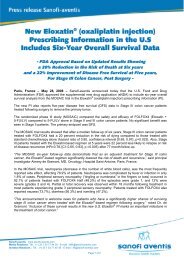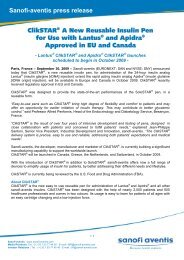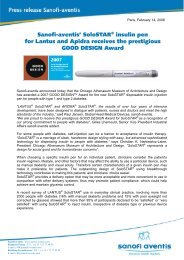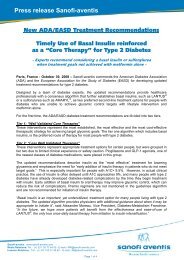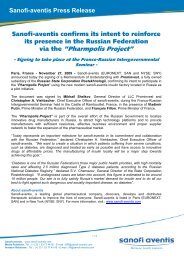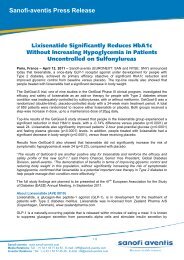European Commission Approved APIDRA® for Treatment of ... - Sanofi
European Commission Approved APIDRA® for Treatment of ... - Sanofi
European Commission Approved APIDRA® for Treatment of ... - Sanofi
You also want an ePaper? Increase the reach of your titles
YUMPU automatically turns print PDFs into web optimized ePapers that Google loves.
About the Study<br />
The approval <strong>of</strong> APIDRA ® <strong>for</strong> pediatric use is based upon a 26-week, phase III, open-label, active<br />
control study <strong>of</strong> APIDRA ® in comparison with Humalog ® , in more than 572 children and adolescents<br />
(4 years and older) with type 1 diabetes.<br />
Study patients received APIDRA ® or Humalog ® 0-15 minutes premeal. These patients received<br />
concomitant treatment with LANTUS ® once daily or NPH twice daily as basal insulin. The majority <strong>of</strong><br />
the patients received Lantus ® as part <strong>of</strong> their basal-prandial regimen (69.7% and 72% in the APIDRA ®<br />
and Humalog ® treated groups, respectively).<br />
The study compared the efficacy <strong>of</strong> APIDRA ® to Humalog ® in terms <strong>of</strong> change in glycohemoglobin<br />
(HbA 1c), which is the amount <strong>of</strong> sugar bound to hemoglobin in the blood. The change in HbA 1c from<br />
baseline to endpoint <strong>for</strong> APIDRA ® and Humalog ® were similar. The mean HbA 1C change in the<br />
APIDRA ® population was +0.10% (± 0.08) and +0.16% (± 0.07) in the Humalog ® group. The difference<br />
between the two treatments <strong>for</strong> this measure was -0.06%, or almost zero, with a 95% confidence<br />
interval <strong>of</strong> (-0.24; 0.12). Postprandial glycemic control, as assessed by the self-monitored blood glucose<br />
values and blood glucose excursions, was similar in both treatment groups at endpoint.<br />
About Type 1 Diabetes<br />
Diabetes is a chronic, widespread condition in which the body does not produce or properly use insulin,<br />
the hormone needed to transport glucose (sugar) from the blood into the cells <strong>of</strong> the body <strong>for</strong> energy. In<br />
patients with type 1 diabetes, the immune system destroys the insulin-producing beta cells <strong>of</strong> the<br />
pancreas that regulate blood glucose. Since the pancreas can no longer produce insulin, people with<br />
type 1 diabetes require daily injections <strong>of</strong> insulin <strong>for</strong> their entire lives.<br />
The International Diabetes Foundation estimates the global number <strong>of</strong> children (14 years <strong>of</strong> age and<br />
younger) with type 1 diabetes to be 440,000, with 70,000 newly diagnosed cases each year.<br />
About LANTUS ® (insulin glargine [rDNA origin])<br />
LANTUS ® is indicated <strong>for</strong> once-daily subcutaneous administration in the treatment <strong>of</strong> adult patients with<br />
type 2 diabetes mellitus who require basal (long-acting) insulin <strong>for</strong> the control <strong>of</strong> hyperglycemia and <strong>for</strong><br />
adult and pediatric patients (6 years and older) with type 1 diabetes mellitus. LANTUS ® demonstrates a<br />
relatively peakless and sustained concentration/time pr<strong>of</strong>ile over 24 hours thus reducing the risk <strong>of</strong><br />
hypoglycemia and allowing a constant and high efficacy over 24h with one single daily injection.<br />
LANTUS ® is the number one prescribed insulin worldwide.<br />
About APIDRA ® (insulin glulisine [rDNA origin])<br />
APIDRA ® is a rapid-acting insulin analog with a unique zinc-free molecular structure that maintains a<br />
rapid onset and a short duration <strong>of</strong> action, indicated <strong>for</strong> adults and now <strong>for</strong> adolescents and children (6<br />
years and older) with diabetes in the EU. APIDRA ® <strong>of</strong>fers patients mealtime dosing flexibility—it can be<br />
taken shortly (0-15 min) be<strong>for</strong>e or soon after the meal. APIDRA ® is also flexible <strong>for</strong> use in a wide range<br />
<strong>of</strong> patients from lean to obese. APIDRA ® is an optimised partner to LANTUS ® once prandial insulin is<br />
required.<br />
About SoloSTAR ®<br />
SoloSTAR ® is a new, easy-to-use disposable pen <strong>for</strong> administration <strong>of</strong> LANTUS ® and APIDRA ® .<br />
SoloSTAR ® allows administering doses from 1 up to 80 units, in one unit increments, in one injection.<br />
SoloSTAR ® <strong>of</strong>fers a 25% greater maximum capacity than other disposable insulin pens, up to 80 units<br />
<strong>of</strong> insulin in one injection. SoloSTAR uses a simple, intuitive design with an easy-to-read display, and<br />
requires only a few steps to use it properly. SoloSTAR ® is small, discreet and eliminates the need <strong>for</strong><br />
the patient to change insulin cartridges. Easy-to-use and easy-to-inject, SoloSTAR ® reduces the<br />
injection <strong>for</strong>ce by 30% or more in comparison to other most broadly available pens in its class. A recent<br />
survey <strong>of</strong> LANTUS ® SoloSTAR ® used in everyday clinical practice, involving more than 2000 people<br />
with diabetes (16% with manual dexterity problems and 15% with poor eyesight not corrected by<br />
glasses) showed that more than 95% <strong>of</strong> participants declared to be “satisfied” or “very satisfied” with<br />
using SoloSTAR ® to inject insulin, irrespective <strong>of</strong> diabetes type or previous device experience.<br />
LANTUS ® SoloSTAR ® and APIDRA ® SoloSTAR ® were approved by the <strong>European</strong> <strong>Commission</strong> in<br />
September 2006; LANTUS ® SoloSTAR ® was approved by the FDA in April 2007. LANTUS ®<br />
Page 2 <strong>of</strong> 3



